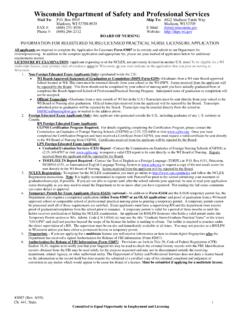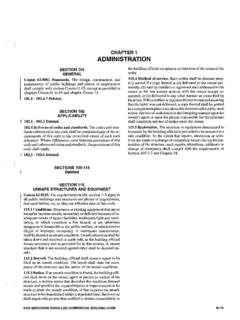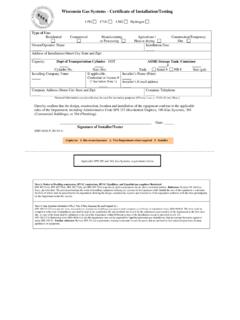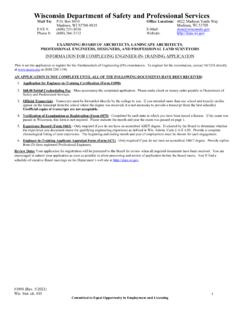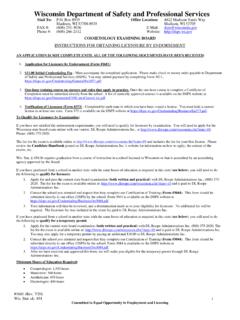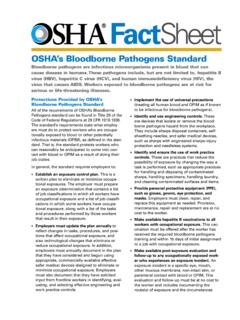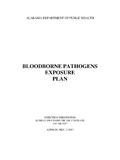Transcription of Bloodborne Pathogens Exposure Control Plan
1 Bloodborne Pathogens Exposure Control plan (Revised). Revised [INSERT REVISION DATE] 1. Table of Contents I. 4. II. AUTHORITY & REFERENCE .. 4. III. APPLICATION .. 4. IV. RESPONSIBILITY FOR COMPLIANCE .. 4. V. Exposure DETERMINATIONS .. 5. VI. METHODS OF COMPLIANCE .. 5. Work Practice Controls .. 6. Universal Precautions .. 6. Post Exposure Incident Investigation .. 6. Sharps Injury 6. Engineering Controls .. 6. Hand Washing .. 8. Housekeeping and Waste 8. Personal Protective Equipment .. 7. Labels .. 10. VII. HEPATITIS B VACCINATION .. 10. VIII. POST- Exposure EVALUATION AND FOLLOW-UP.
2 11. IX. COMMUNICATION ABOUT HAZARDS TO EMPLOYEES .. 13. Warning Labels .. 13. Employee Training .. 13. X. RECORDKEEPING .. 14. Medical Records (See Appendix F): .. 14. Training Records (See Appendix H) .. 15. XI. EVALUATION AND REVIEW .. 15. APPENDIX ERROR! BOOKMARK NOT DEFINED. Revised [INSERT REVISION DATE] 2. Table of Contents APPENDIX B .. 1. APPENDIX C .. 1. APPENDIX ERROR! BOOKMARK NOT DEFINED. Revised [INSERT REVISION DATE] 3. Bloodborne Pathogens Exposure Control plan I. PURPOSE. The objective of this Bloodborne Pathogens Exposure Control plan is to comply with the Occupational Safety and Health Administration's Bloodborne Pathogens Standard, 29 CFR , and to eliminate or minimize employee occupational Exposure to blood, certain other bodily fluids or other potentially infectious materials.
3 Definitions of terms relating to this Exposure Control plan are found in Appendix A. II. AUTHORITY & REFERENCE. Occupational Safety and Health Administration (OSHA) 29 CFR III. APPLICATION. This Exposure Control plan (ECP) applies to [FACILITY] employees who are engaged in workplace activities that may involve exposures to blood or other bodily fluids. IV. RESPONSIBILITY FOR COMPLIANCE. [RESPONSIBILITIES MAY BE DISTRIBUTED DIFFERENTLY BASED ON. THE FACILITY'S SITUATION]. The implementation of this ECP will be the responsibility of the [TITLE OF. RESPONSIBLE PERSON].
4 These responsibilities will include Maintaining, reviewing and updating the ECP at least annually and whenever necessary to include new or modified tasks and procedures. Providing and maintaining all necessary personal protective equipment (PPE), engineering controls, labels and red bags as required by the standard. Ensuring all medical actions required by the standard are performed and that the appropriate employee health and OSHA records are maintained Revised [INSERT REVISION DATE] 4. Providing hepatitis B vaccines under specific circumstances as defined by an Exposure determination and/or medical follow-up for Exposure incidents.
5 Ensuring that annual and initial training is conducted and documented Ensuring that the written ECP is available to employees and others as required Supervisors shall themselves follow and ensure that their employees are trained in and use proper work practices; universal precautions; personal protective equipment; and proper cleanup and disposal techniques. Employees are responsible for attending required training; utilizing proper work practices; universal precautions; personal protective equipment; and proper cleanup and disposal techniques. Employees are also responsible for immediately reporting all Exposure incidents to [TITLE(S) OF RESPONSIBLE PERSON(S)].
6 V. Exposure DETERMINATIONS. The [TITLE/NAME] will determine which employees can reasonably be expected to be exposed to blood or other body fluids containing blood in the course of their work. These Exposure determinations may be performed with the assistance of a qualified person(s) ( occupational, public health or infection Control nurse, industrial hygienist or safety professional) or a committee consisting of qualified persons with appropriate education, experience and/or training. Exposure determination shall be updated as job classifications or work situations change and shall be made without regard to the use of personal protective equipment.
7 The [TITLE(S)/NAME(S)] has identified the following job classifications as those in which employees could be exposed to Bloodborne Pathogens in the course of fulfilling their job requirements: JOB TITLES. VI. METHODS OF COMPLIANCE. [ADDITIONAL METHODS OF COMPLAINCE MAYBE IMPLEMENTED. BASED ON THE FACILITY'S OPERATIONS-SEE Bloodborne . PAHTOGENS WRITTEN PROGRAM CHECKLIST LOCATED ON THE DSPS. WEBSITE Programs/Public-Sector-Employee-Safety/P ublic-Sector-Employee-Safety- Publications/]. Revised [INSERT REVISION DATE] 5. Work Practice Controls Universal Precautions All employees will utilize universal precautions to prevent contact with blood or other potentially infectious materials (OPIM).
8 All blood or other potentially contaminated body fluids will be considered to be infectious regardless of the perceived status of the source individual. Under circumstances in which differentiation among body fluid types is difficult or impossible, all body fluids will be considered potentially infectious materials. Exposure Control plan (ECP). Employees covered by the Bloodborne Pathogens standard received an explanation of this ECP during their initial training session. The ECP will also be included as part of the annual refresher training. All employees can obtain a copy of this plan by contacting the [TITLE/NAME].
9 Post Exposure Incident Investigation An Exposure incident is defined as contact with blood or OPIM on non-intact skin, eye, mouth or other mucous membrane and includes piercing of the skin or mucous membranes by needles or other sharp objects. An Exposure incident investigation form will be completed each time an Exposure incident occurs (See Appendix B). Sharps Injury Log A needle stick/sharps injury log shall be maintained and shall include the following information for each incident: Period of time the log covers Date of the incident Date the incident is entered into the log Type and brand of sharp involved Department or area of incident Description of the incident The log(s) shall be retained for five years after the end of the log year.
10 Appendix D contains a copy of the Sharps Injury Log. Engineering Controls The following engineering controls shall be used: Sharps containers Biohazard bags/containers Engineering and work practice controls are designed to eliminate or minimize employee Exposure . Where occupational Exposure remains after institution of these controls, personal protective equipment will be used. Revised [INSERT REVISION DATE] 6. Personal Protective Equipment The [TITLE(S)/NAME(S)] will ensure that appropriate personal protective equipment is readily accessible at the worksite.
